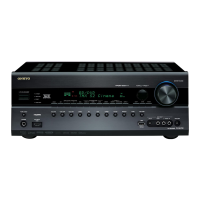71
En
Controlling Zone 2 with the Remote
Controller
Note
• To control Zone 2, you must press the remote controller’s
ZONE2 first.
• ZONE2 turns red while Zone 2 is on.
Note
• Only analog input sources are output by the ZONE 2 LINE
OUT and FRONT WIDE/ZONE 2 L/R terminals. Digital input
sources are not output. If no sound is heard when an input source
is selected, check if it’s connected to an analog input.
• You cannot select different AM or FM radio stations for your
main room and Zone 2. The same AM/FM radio station will be
heard in each room. For example, if you have an FM station for
the main room, that station will also be used in Zone 2.
• When you connect Zone 2 speakers directly to the AV receiver,
listening modes that require surround back speakers or front high
speakers or front wide speakers (6.1/7.1), such as Dolby Digital
EX, DTS-ES, THX Select2 Cinema, Dolby Pro Logic IIz
Height, and Audyssey DSX™ are unavailable.
• When the input selector of Zone 2 is selected, power consump-
tion on standby mode slightly increases.
• While Zone 2 is on, u functions will not work.
Adjusting the Volume for Zone 2
■ Operating with the remote controller
■ Operating on the AV receiver
If your Zone 2 speakers are connected to a receiver or inte-
grated amp in Zone 2, use its volume control to adjust the
volume.
Muting Zone 2
■ Operating with the remote controller
Tip
• To unmute, press ZONE2 followed by MUTING again.
1
Press ZONE2, then point the remote controller at
the AV receiver and press ON.
Tip
•The ZONE 2 12V TRIGGER OUT goes high (+12 V).
2
To select an input source for Zone 2, press
ZONE2, followed by INPUT SELECTOR.
To select AM or FM, press TUNER input selector
and ZONE2 repeatedly.
(North American models) You can also select SIR-
IUS.
3
To turn off Zone 2, press ZONE2, followed by
STANDBY.
INPUT
SELECTOR
ON
ZONE2
STANDBY
1
Press ZONE2.
2
Use VOL q/w to adjust the volume.
1
Press ZONE 2 (the ZONE 2 indicator and Zone 2
selector on the display flashes).
2
Use –/+ within 8 seconds to adjust the volume.
Press ZONE2 followed by MUTING.

